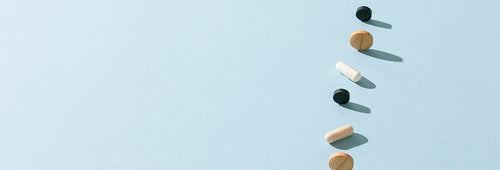Iron
While we often hear about vitamin deficiencies resulting from our industrial diet, which causes us to consume less and less fruit and vegetables, there is an essential trace element whose deficiency is much more widespread: the iron.
According to the WHO , it is simply the most common nutritional disorder in the world ! More than 30% of the world's population suffers from anemia due to iron deficiency. And this does not spare industrialized countries, where it is also very widespread.
But actually, what is iron? What is its role in the body, where is it found? And what would happen if, like 2 billion people around the world, you lacked iron?
We tell you everything in this complete guide to iron 🧲

What is iron in the body?
Iron is a trace element among others, such as magnesium, chlorine, sodium, sulfur... These are mineral salts essential for the proper functioning of the human body, and living beings in general. Unlike macroelements (such as hydrogen, oxygen or carbon), trace elements are present in very small quantities in the body: less than 1 gram per kilo of body weight.
Despite their very low presence, trace elements remain nonetheless fundamental. They perform many roles, such as helping with enzyme production, muscle contraction or energy production, and are part of many components of the body such as bones, teeth or hemoglobin.
It is precisely in hemoglobin that we find iron. Its main role is to participate in the transport of oxygen via red blood cells present in the blood. But, in smaller quantities, this iron is also used to store oxygen, as well as ensure the proper functioning of various other cells throughout the body.
There are mainly two types of iron: heme iron , especially present in meat and fish, and non-heme iron (in vegetables and dairy products). The first is better absorbed than the second, and both are brought to the body during digestion.
The main sources of iron in the diet
As we have just said, heme iron , more easily absorbable by the body , is mainly found in products of animal origin, unlike non-heme iron, which is more present in certain vegetables and plants.
Here are the main sources of heme iron 🐮:
- Seafood: clams, mussels, oysters, periwinkles, etc.;
- Meat (especially liver): beef, rabbit, pork and lamb offal, etc.;
- Certain fish: cuttlefish, octopus, octopus, tuna…
For non-heme iron 🌿, let us quote:
- Algae: spirulina and kelp;
- Soybeans and soybeans, as well as sesame seeds;
- Certain legumes: lentils, yellow beans (raw), ginger root, broad beans, chickpeas, cashew nuts, etc.;
- Aromatics: basil, thyme, cumin;
- Chocolate (with a high cocoa content).
For better absorption and faster completion of daily requirements, heme iron, of animal origin, is preferable to non-heme iron. But foods that contain non-heme iron will make a very good alternative for vegans, for example.
And the spinach in all this?
Their reputation as strong iron suppliers is actually not really valid. They do contain iron, but less than 5 mg per 100 grams. A proportion approximately twice less than the same quantity of yellow beans, or three times less than oysters or veal kidneys. Not so miraculous after all, from an iron point of view!
What are the daily iron requirements?
Iron needs vary between individuals , their sexes and the different periods of their life.
For an adult man, the recommended daily intake in France is 9 mg , while it is 14 mg for women. For adolescent boys, this intake increases to 13 mg/day, while it rises to 16 mg/day for adolescent girls. Conversely, over the age of 50, both men and women would only need 8 mg/day of iron.
Requirements increase during periods of growth, but are also higher for women due to the loss of iron during periods. In the event of pregnancy, this daily intake would increase to 27 mg.
We recommend you
Iron Bisglycinate
Formula based on highly assimilable Ferrochel® iron bisglycinate.
- ✅ Chelated iron (high bioavailability)
- ✅ 14 mg of elemental iron per capsule
- ✅ With Vitamin C Quali®-C
- ✅ 3 months of treatment
Iron deficiency: symptoms and risks
As we have seen, iron deficiency is a very widespread scourge, and the number one nutritional disorder in the world according to the WHO. The number 1 risk associated with it is anemia . This is a blood abnormality characterized by an abnormally low number of red blood cells. It is detected during a blood test: if the hemoglobin level is lower than 13 g/dL for an adult man, or 12 g/dL for a (non-pregnant) woman, we then speak of anemia.
Anemia or iron deficiency often results in the same symptoms, although anemia can arise from other causes. We speak of iron deficiency anemia or iron deficiency anemia when it is actually explained by an iron deficiency in the body.
Some of the main symptoms of iron deficiency include:
- Pallor: skin and mucous membranes become abnormally pale. Caution: the paling of the skin is very gradual, and can go unnoticed given the length of time it lasts. A professional can look inside the lower eyelid to diagnose iron deficiency.
- Fatigue and dizziness: as iron is involved in certain muscle proteins, its deficiency can lead to general fatigue, or unusual difficulties during exercise.
- Palpitations, tachycardia: as the blood lacks oxygen due to the lack of iron (the main purpose of which is to transport this oxygen in hemoglobin), the body accelerates the heart to compensate and ensure acceptable oxygenation.
- In cases of severe and prolonged anemia, neurosensory symptoms may appear: dizziness, headache, tinnitus, etc.
As a general rule, anemia therefore reduces physical and intellectual capacities , as well as resistance to infections and diseases . In addition to these disabling daily symptoms, serious anemia that is not treated can also lead to disruptions in the menstrual cycle, or even a potentially fatal coma. This is therefore not a health problem to be underestimated!
To remedy this, the simplest solution is to increase your consumption of foods rich in iron . But in the event of a serious and long-standing deficiency, supplementation can also be used to quickly restore an acceptable hemoglobin level.
Benefits of iron: a more than essential micro-nutrient!
We will have understood, iron is not an essential trace element for nothing. As we said, a good dose of iron in the body contributes to effective oxygenation of muscles and organs, via hemoglobin in the blood. This oxygenation makes breathing easier, especially during exercise or sports.
Iron helps you stay in good shape in general . It helps fight fatigue and "sluggishness", particularly because it is involved in the production of adenosine triphosphate (ATP), an energy source molecule to operate the metabolism of the human body.
But it also has other functions, such as the storage of oxygen (in addition to its transport in the blood), or the production of certain neurotransmitters and hormones . Finally, iron is involved in the creation, growth and differentiation of cells.
How to choose the right iron supplement?
If you feel particularly tired and think you have a pressing iron deficiency to correct, you can turn to iron-based food supplements. Be careful though, not all are equal!
There are several forms of iron to take orally, such as ferrous sulfate, more affordable but less easily assimilated and tolerated by the body: it can cause diarrhea, constipation or nausea. To avoid these inconveniences, we recommend the bisglycinate form instead : through its binding of iron with glycine, this form of supplement offers much more efficient absorption of iron, as well as fewer negative side effects .
Finally, for an optimized effect of your iron treatment, we suggest combining it with vitamin C , which significantly increases iron absorption. To a lesser extent, you can also consume meat or lemon juice to improve the effectiveness of your iron supplement.
Conversely, avoid tea and coffee during iron cures, drinks which reduce absorption.
The final word
This completes this complete guide to iron. We hope that it has been useful to you, and has taught you more about this trace element that is so important and yet so often lacking in our plates! If you experience general fatigue, difficulty exercising or other symptoms described here, consider having your hemoglobin level analyzed: you may simply be lacking iron.
If necessary, iron supplementation can deal with the most urgent, but as always, no secret: the healthiest and most accessible solution remains a varied and balanced diet!














